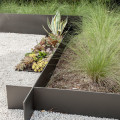Concrete Retaining Walls
Concrete retaining walls provide lateral support for backfills. (A backfill is a vertical slope of earth held back from an adjacent level plain.) These structures offer some very important benefits to homeowners investing in residential landscape design.
On a functional level, they ensure that the constantly shifting and crumbling claylike soil of Houston is stabilized as much as possible with advanced surface leveling and drainage techniques. This is particularly true for Houston homeowners who live anywhere near Buffalo Bayou or one of its tributaries. Backyards in these neighborhoods often slope toward the banks of the stream.
A concrete retaining wall, and corresponding drainage system, provides not only a more level yard for landscape design, but also functions as an erosion control system.
On an aesthetic level, concrete retaining walls also offer the professional landscape designer many opportunities to blend function with form. These structures can be used to build any number of landscape elements such as raised gardens, flower beds, private patios, and outdoor fireplaces.
The concrete used to make these structures can be rendered highly decorative and modified to look like a stone wall or a masonry wall. The structure can be supported simply by the weight of the stacked concrete blocks (a form known as a gravity wall), or it can be mortared together as bricks and stones are mortared in professional masonry.
Another way of building a gravity concrete retaining wall is to simply cast the entirety of the wall and erect it in a single piece. This uses more concrete than faux masonry designs, but the labor costs are significantly lower. Smaller walls in this design are highly effective provided there is adequate drainage built into the wall’s design.
Multiple walls of this type are ideal on contemporary Houston landscapes that showcase outdoor art. Such a wall can also serve as the front piece for a contemporary fountain or a contemporary garden. The stark absolutism of concrete in its raw, natural form lends itself very well to the Mentalist intent inherent to contemporary landscape design.
Then again, some modern landscapes are highly colorful and can be rendered even more avant garde in expression by using a concrete wall as an edifice for modern painting. Any number of geometric patterns and unique combinations of colors can transform the surface into a thematic focal point for themes common to hardscape, garden, and home architecture design.
On commercial properties, or residences near watersheds with very steep grades, we can reinforce a concrete retaining wall by building it in a cantilever design. This design uses short wing walls called buttresses that are built at right angles to the wall’s vertical surface. These buttresses redistribute the force of gravity backward and downward into the ground. This gives the wall additional strength in the face of great pressures.
Cantilevered designs are more expensive to build. Although the amount of concrete is less than that of gravity walls, there is greater labor involved in terms of design and construction. Combinations of the gravity design and cantilever design can also be custom engineered, depending on the nature of the project and the environment at hand.
The most important thing for every resident and business to realize when it comes to building retaining walls is the absolute necessity for a reliable drainage system to be integrated into the design. Hydrated soil increases in weight, so keeping the earth behind the wall as dry as possible ensures that mass differential and distribution ratios remain consistent regardless of weather conditions.


